Cost of Firewood 2024
- September 13, 2023
- 0 comment
Who doesn’t love the comforting aroma of firewood on a chilly night? This age-old source of warmth, with its crackling logs and dancing flames, has been the heart of many homes for generations. But in our rapidly evolving world, what’s the real cost of this nostalgic comfort? From the dense woods, it’s sourced from to your cozy living room, there’s a tale of economy, sustainability, and even global shifts hiding in each log. So, pull up a chair, and let’s stoke your curiosity as we delve deep into the fascinating world of firewood costs.
1. The Basics: Cord Measurement
Firewood measurement has its own language and units, and for those unfamiliar, it might feel like decoding a mystery.
What is a Cord?
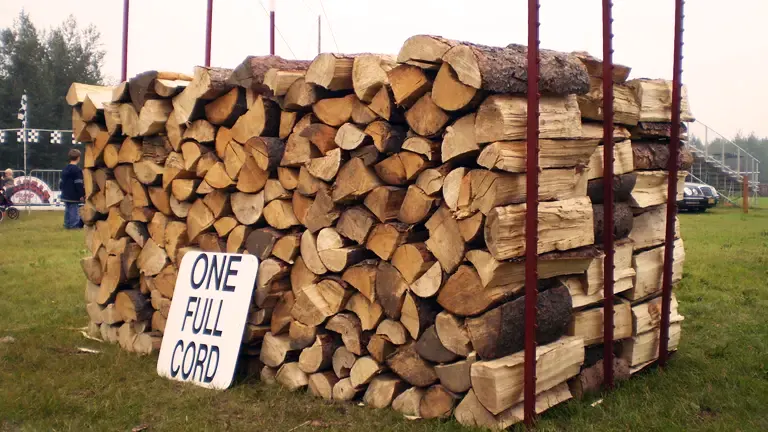
The cord has been the standard measure for selling firewood for centuries. Picture this: a voluminous stack of wood reaching 4 feet in height, stretching 8 feet in length, and pushing 4 feet out in width. This 128 cubic feet stack represents what is known as a full cord. It’s the gold standard against which other measurements are often compared.
Variations: Face Cords and Ricks
While a full cord might sound straightforward, here’s where things can get a bit tricky. Not everyone buying firewood needs or has space for a full cord. Enter the face cord and Rick.
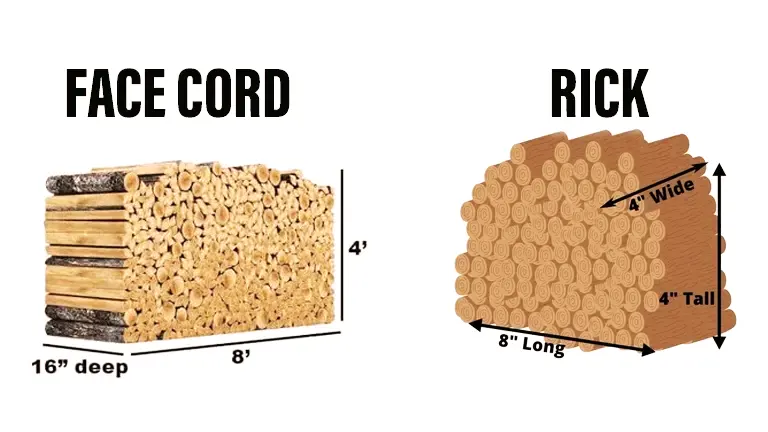
- Face Cord: A face cord, often just called a “face,” doesn’t have a standard depth. Its height and length mirror that of a full cord, being 4 feet high and 8 feet long, but the depth can vary based on the length of the firewood pieces. Commonly, firewood pieces are 16 inches long, making a face cord one-third the volume of a full cord. However, this can change if the logs are cut longer or shorter.
- Rick: The term “rick” is more regional and can be synonymous with a face cord in some areas. Its dimensions can also vary, often adding to the confusion. The key is always to ask the seller for the exact dimensions when purchasing a rick of wood.
Why Such a Measurement?
The origins of this particular measurement are somewhat lost in history. However, the dimensions likely became standard because they’re manageable and create a stack that’s stable and easy to visually assess. Moreover, these dimensions allow for optimal drying of the wood when stacked properly.
Why Does It Matter?
Being knowledgeable about these measurements is crucial when purchasing firewood. Sellers usually quote prices based on cords, face cords, or ricks. A lack of understanding can mean you either overpay or end up with less firewood than you intended. Always clarify the exact volume you’re getting for your money. Additionally, understanding the measurement system aids in proper storage and in gauging how long your firewood supply will last.
2. Factors Affecting Firewood Prices
The price of firewood isn’t set in stone; instead, it oscillates based on a myriad of factors that interplay with one another. Let’s dissect these factors in detail, allowing you to comprehend the intricacies of firewood pricing.
A. Type of Wood
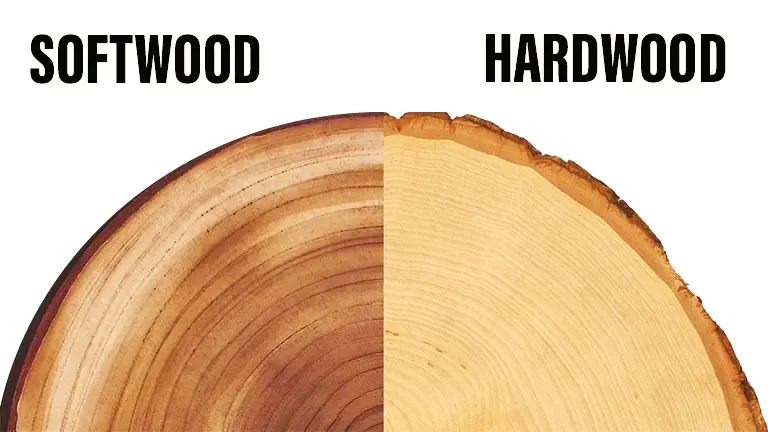
The type of wood you choose plays a pivotal role in the cost equation. Here’s why:
- Hardwoods: Species like oak, cherry, and hickory fall under the hardwood category. These woods have a dense cellular structure, which means they pack more energy and burn hotter and longer. If you’re looking for efficient heating and fewer trips to the woodpile during a cold evening, hardwoods are your best bet. However, their superior burning properties come with a heftier price tag.
- Softwoods: On the other side of the spectrum are softwoods like pine, cedar, and spruce. These woods ignite quickly and are great for kindling or quick burns but don’t offer the lasting warmth of hardwoods. Their shorter burn time and relative abundance often make them more affordable.
B. Region and Availability
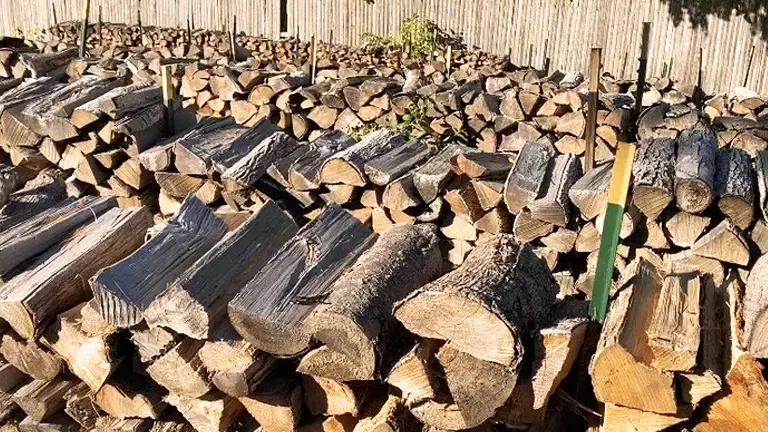
When we hear the chant “location, location, location,” our minds often dart to the bustling world of real estate. However, this mantra rings true in the somewhat quieter, yet equally intriguing, domain of firewood. Geography and the bounty it offers significantly shape the cost dynamics of firewood.
In regions blessed with sprawling expanses of forests, there’s a natural cornucopia of timber. This bountiful supply does more than just paint a scenic backdrop; it plays a direct role in dictating firewood prices. Abundant forests mean that the journey from tree to hearth is a shorter one, cutting down on transportation and logging expenses. Consequently, the price tags in these verdant areas are often more wallet-friendly.
But there’s another layer to this geographic tapestry. The Earth’s vast expanse hosts a myriad of tree types, each unique to its habitat. One might find birch trees as common as the morning song of a robin in one region, while in another, they might be as rare as a precious gem. This regional variation in tree types creates a fascinating marketplace where the price of specific wood, like birch, can waver dramatically based on its local abundance or scarcity. It’s a reminder that when it comes to firewood, the story and price are woven deeply into the very soil and air of a place.
C. Seasonality

In the ever-fluctuating world of commerce, the age-old principles of supply and demand play a pivotal role, and the firewood market stands as no exception to this rule. As the chill of winter begins to weave its icy tendrils, households instinctively turn to the comforting embrace of fireplaces and wood-burning stoves. This natural gravitation towards warmth during the colder months inevitably fuels a spike in firewood demand. This “Winter Surge” isn’t merely a surge in consumption; it’s a crescendo in prices. Sellers, being astutely aware of the heightened need, often adjust their rates to capitalize on this seasonal trend. However, nestled within this cyclical dance of demand is an opportunity for strategic buyers. Those with foresight, or perhaps just a knack for frugality, often sidestep the winter price inflation. They make their move during the sun-drenched days of summer or the mild breezes of spring. By tapping into “Off-Season Purchasing,” these savvy consumers not only ensure their stockpile is ready well in advance but also benefit from the comparatively reduced prices when firewood isn’t the talk of the town.
D. Preparation
How firewood is prepared post-harvest can significantly impact its cost:
Kiln-Dried Wood
Kiln drying is a process where wood is placed in a specialized oven to reduce moisture content rapidly. This not only ensures a cleaner, more efficient burn but also minimizes pests like termites or wood beetles. The energy and time-intensive nature of this process adds to the cost, making kiln-dried wood a premium option.
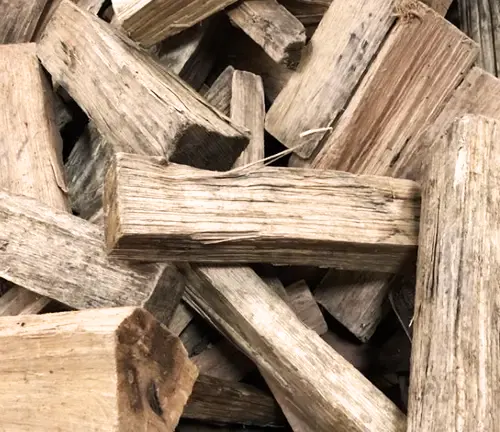
Green or Freshly-Cut Wood
In contrast, wood that’s freshly cut and hasn’t undergone any special drying processes is referred to as “green.” While more affordable, it has a higher moisture content and may not burn as effectively until properly seasoned.

E. Delivery and Stacking

In today’s world, where almost everything can be delivered straight to our doorsteps, firewood has seamlessly integrated into this trend. Transporting these hefty stacks isn’t a mere matter of relocation; it’s a dance of logistics, careful handling, and understanding the nuances of wood storage. While many sellers recognize the growing demand for home delivery, bringing this age-old source of warmth right to your backyard, they often attach a fee for this valued convenience. But the spectrum of services doesn’t end at mere delivery. Some forward-thinking providers aim to enhance the customer experience by offering stacking services. By doing so, they ensure that the firewood is not only delivered but also meticulously arranged, optimizing storage efficiency and ensuring it’s fireplace-ready. As tempting as it sounds to have your logs laid out perfectly without lifting a finger, it’s worth noting that this premium service usually incurs an extra charge, balancing out the scales of convenience and cost.
3. Trends Impacting Firewood Costs
In our rapidly changing world, firewood prices don’t exist in a vacuum. From environmental shifts to technological advancements, several contemporary trends exert influence on the cost dynamics of firewood. Let’s navigate through these complexities for a clearer understanding.
A. Climate Change: The Environmental Overarch
The ramifications of climate change are vast and varied, and the firewood industry is not immune:
- Weather Patterns: Inconsistent and unpredictable weather can play havoc with tree growth cycles. Extended droughts might stunt growth, while sudden storms could destroy mature wood sources. Such erratic patterns can result in reduced wood availability, nudging prices upward.
- Forest Fires: Once a natural part of certain ecosystems, forest fires are now occurring with alarming frequency and intensity in many parts of the world. These fires not only obliterate vast tracts of forest but also diminish the immediate supply of harvestable wood, leading to potential price hikes.
B. Pest Infestations: The Tiny Destroyers
While they might be small in size, pests can wreak massive destruction:
Emerald Ash Borer
This invasive beetle has made headlines by decimating ash tree populations in various regions. As these trees die off, there’s a decreased availability of ash wood, often leading to increased prices. Moreover, as sellers pivot to alternative wood types, it can shift the supply-demand dynamics for those woods too.

Other Pests
The emerald ash borer is just one example. Many other pests, like the pine beetle, also impact forests, reshaping the availability and pricing structure of affected woods.

C. Urban Development: The Concrete Expansion
The concrete jungles we inhabit have a direct bearing on the green ones:
- Deforestation: As cities expand and infrastructure projects multiply, forests often pay the price. Logging to make way for development reduces the local supply of firewood. With reduced local sources, wood might need to be transported from farther away, increasing costs.
- Land Competition: Land that might have been used for sustainable timber farming might now be repurposed for housing or commercial use, further dwindling the supply sources.
D. Alternative Heating Methods: The Technological Revolution
As technology evolves, so do our methods for staying warm:
- Pellet Stoves: These stoves use compressed wood or biomass pellets, offering a cleaner and often more efficient heat source than traditional firewood. Their rising popularity might reduce demand for regular firewood, potentially influencing prices.
- Electric Heaters: With advancements in energy efficiency, many households are turning to electric heating solutions. Reduced reliance on traditional firewood for heating can result in a decreased demand, and over time, this could influence the pricing structure of the firewood market.
4. Making the Most of Your Firewood Investment
Every firewood purchase represents not just a monetary investment but also an investment in warmth, comfort, and perhaps even nostalgia. To ensure you reap optimal benefits from this investment, consider the following guidelines designed to enhance the utility and longevity of your firewood.
A. Storing with Foresight
The manner in which you store your firewood can significantly impact its quality and longevity:
- Elevation is Key: Resting your firewood directly on the ground exposes it to moisture, pests, and rot. Elevate your stacks using pallets or specially designed firewood racks. This ensures air circulation beneath the wood, reducing moisture accumulation and enhancing drying.
- Shield from Rain and Snow: While it’s beneficial for firewood to be exposed to wind (to aid drying), direct exposure to rain or snow can be detrimental. Consider a roofed storage area or use tarps to protect the top of the stack while ensuring the sides remain open for ventilation.
- Orientation Matters: If possible, align your firewood stack in the direction of the prevailing wind. This promotes better air circulation, speeding up the seasoning process and keeping the wood dry.
B. Efficient Burning
Making small changes in the way you burn firewood can lead to increased heat output:
- Fireplace Inserts: These are specially designed units that fit into existing fireplaces. They trap the heat and radiate it into the room, reducing the amount of warmth that escapes up the chimney. This means you use fewer logs for the same warmth, stretching your firewood supply further.
- Seasoned Over Green: Always opt for well-seasoned wood over green or unseasoned wood. Seasoned wood has a lower moisture content, ensuring it burns hotter and more efficiently. Greenwood, on the other hand, expends a lot of its energy evaporating the contained moisture, leading to cooler, smokier fires.
C. Economical Purchasing
Like many commodities, purchasing firewood can offer economies of scale:
- Reduced Per-Cord Costs: Sellers often provide discounts for larger purchases. Buying in bulk can lead to significant savings on a per-cord basis.
- Stable Supply: Bulk purchasing ensures you have a stable supply for a longer duration. This can be especially beneficial in peak winter months when prices might surge, or supply becomes erratic.
- Fewer Deliveries: If you’re getting the wood delivered, larger, less frequent deliveries can save on associated delivery fees.
5. Sustainability and Firewood
The allure of a cozy fire goes beyond immediate warmth, reflecting our broader responsibility to the environment. Purchasing local firewood not only reduces the carbon footprint from transportation but also supports community-based loggers, fostering an ecosystem of sustainable logging practices. Choosing wood sourced from sustainably managed forests, marked by certifications such as the Forest Stewardship Council (FSC), is crucial. This approach ensures that the forests can regenerate naturally, maintaining biodiversity, safeguarding freshwater sources, and preventing soil erosion.

Moreover, forests aren’t merely clusters of trees but complex ecosystems that play host to diverse flora and fauna. When we prioritize sustainable logging, we’re also indirectly championing the conservation of countless species, promoting healthy soil, and protecting critical water resources. Our choices today, centered around responsible firewood sourcing, guarantee that the comforting glow and crackle of our firesides remain a renewable luxury, fostering a sustainable relationship with nature for generations to come.
Conclusion
The cost of firewood is influenced by myriad factors, from the type of wood to global economic trends. By understanding these elements, consumers can make informed decisions, ensuring they enjoy the warmth of a blazing heart without burning a hole in their wallets.
You can check our Wood Section for an even more comprehensive look into the world of wood and its countless applications. There’s a wealth of knowledge waiting for you there, so dive right in and embark on your next enlightening read. Happy exploring!
FAQs
- Why is exotic firewood more expensive than local varieties?
Exotic firewood often comes from trees not native to the region. Their cost can be higher due to import taxes, transportation costs, and the uniqueness of the wood itself. - How does the health of a forest impact firewood prices?
A healthy forest can sustainably provide more wood over time. Conversely, a forest affected by pests or diseases might produce less viable wood, potentially driving up prices. - Can the age of the tree affect the cost of firewood?
Yes, older trees often produce denser wood, which can burn longer and hotter. This higher quality can command a premium price. - Does the method of logging influence the price?
Sustainable logging practices, while environmentally friendly, might have higher operational costs, which could be reflected in the price of the firewood. - Why might firewood from urban tree removal be pricier?
Urban tree removal often requires more care to avoid damaging surrounding structures, increasing the cost of retrieval, which can affect firewood prices. - How do transportation costs factor into firewood pricing?
The farther the wood has to travel, the higher the transportation costs. These costs can significantly impact the final price, especially for buyers far from forests. - Why do some sellers offer subscription or bulk-buying discounts?
Selling in bulk or through subscriptions ensures a consistent demand for sellers, allowing them to optimize operations and pass on savings to the consumer. - Do local regulations and permits affect firewood prices?
In areas where logging is tightly regulated, permit costs or restrictions can influence the quantity and cost of available firewood. - How does wood seasoning influence its cost?
Seasoned wood, which has been dried to reduce moisture, often burns better than green wood. The extra time and space required for seasoning can increase its price. - Is there a “peak season” for buying firewood at a discount?
Much like other commodities, firewood can have seasonal price fluctuations. Buying during off-peak seasons, like spring or early summer, might yield better deals.
We’d love to hear from you! Share your personal experiences and thoughts about the cost of firewood in 2024 in the comments section below. Your insights could help fellow homeowners and enthusiasts make informed purchasing decisions!

John Carlos
Forestry AuthorThe beauty of logging isn't just about felling trees. It's about understanding nature, mastering the art of chainsaws, and respecting the environment. I believe in sharing my experiences and knowledge, ensuring that we move towards a sustainable future together.









Leave your comment